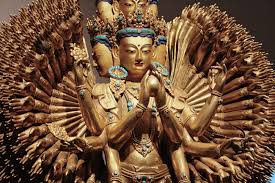Composed by Shunda Wallace

Tibetan Buddhism by contrast is more of a hybrid spiritual practice due to Buddhism’s penetration of Tibet from India. By this time Indian Buddhism was quite different from what it had been during the time of Buddha, becoming quite heavily influenced by Hinduism. In Tibetan Buddhism many of the Tantric practices are derived from Hinduism subsequently there are Goddesses with multiple arms and colorful

Object’s rich in symbolism that represents both Hinduism and Buddha. In Tibetan Buddhism, the most complex symbols are the Tantra practices, which involve visualizing meditational deities. The man that discovered the Buddhist message was Siddhartha Gautama born around 550 BC in Kapilavastu on the border of India and Nepal.
Hundreds of years later Buddhism took on a more feminist perspective from Machik Labdron who received in-depth Prajna Paramita (the perfection of transcendent wisdom) from great Indian Yogi Dampa Sangye. According to many Tibetan scholars the philosophical lineage of Chod came from Dampa while Machik shaped and molded the practice more into a practice of her own. Machik had hundreds of thousands of followers throughout her lifetime from Central Asian regions that included Buriat, Nepal, Mongolia and of course Tibet. The night before Dampa and Machik met, Machik had a dream about him. Later she asked Damp how could she help others and he replied:
“Confess all your hidden faults
Approach that which you find repulsive
Whoever you think you cannot help-help them
Anything you are attached to let go of it
Go to places like cemeteries that scare you
Sentient beings are limitless in the sky
Be aware
Find the Buddha in yourself”
Therefore Chod means “to cut” from the physical attachments of people and external phenomena. By letting go of physical attachments, external phenomena and conceptual thought, emptiness is revealed, not as a dead nothingness but as a vibrant womb of full stillness revealed (a quiet mind). This kind of insight accomplished through meditation is beyond mere words. Additionally Chod means to cut from our source of dissatisfaction, cut off our emotional source of suffering. One offering of the practice is the red offering where visualization of ones skull cap is “cut”. The skull cap is cut in order to make a huge pot. Within this pot one must offer their body, cooking the consciousness out of the body thereby transforming one’s body as a great offering to the deity of one’s own source of suffering.
Currently there are two ways to utilize Chod practice:
Way One: Isolate oneself on the mountain away from everyone and practice
Way Two: To walk the streets of the town and practice. In some Tibetan communities, this would be considered the behavior of a beggar (like American musicians that play on the street for money).
During the mid-twentieth century, the practice has subsided then later re-emerged therefore Chod incorporates a woven texture combination of text, melody, visualization and gesture while utilizing Tibetan instruments that include the two-sided damaru drum, the Tibetan bell, the thighbone trumpet as well as the human voice. The word Chod in Tibetan culture means, “to cut” off from the root of egoic mind identified suffering also known as samsara. During the traditional popularity of Machik’s epoch, monks and nuns practiced Chod during spiritual gatherings at nearby Temple’s and Monasteries for all throughout the community to see. Today Chod practices are no longer restricted to ordained monastics. Due to the subsequent lack of exclusivity among practitioners, Chod is now open to all and any as a form of ritualistic practice. The Chod tradition was on the verge of extinction but is now making a come-back as Llamas are placing emphasis on its efficacy. Now that this traditional practice is re-emerging in both the East and the West (exclusively among practitioners of Asian origin) it is important to document all aspects of the practice that include the tradition of performing ritualistic liturgies derived from the Indian doha Sanskrit language, the oral tradition (chants), the melodic and harmonic implications in addition to the aesthetically astounding performance tradition.
Ms. Wallace holds a Bachelors of Music in Music Management from William Paterson University, Masters Degree in Jazz Arranging and Orchestration from William Paterson University in addition to an Advanced Level Certification in Music Therapy from Montclair State University.
Ms. Wallace’s research on Schizophrenia and Depression was published in Montclair State Universities “Forward Thinking” newsletter and presented/nominated for an award at Montclair State’s 2013 Research Symposium.